
The Balinese people are an Austronesian ethnic group native to the Indonesian island of Bali. The Balinese population of 4.2 million live mostly on the island of Bali, making up 89% of the island's population. There are also significant populations on the island of Lombok and in the easternmost regions of Java.

Besakih Temple is a pura complex in the village of Besakih on the slopes of Mount Agung in eastern Bali, Indonesia. It is the most important, largest, and holiest temple of Balinese Hinduism, and one of a series of Balinese temples. Perched nearly 1000 meters up the side of Gunung Agung, it is an extensive complex of 23 separate but related temples with the largest and most important being Pura Penataran Agung. The temple is built on six levels, terraced up the slope. The entrance is marked by a candi bentar, and beyond it, the Kori Agung is the gateway to the second courtyard.

Tanah Lot is a rock formation off the Indonesian island of Bali. It is home to the ancient Hindu pilgrimage temple Pura Tanah Lot, a popular tourist and cultural icon for photography.
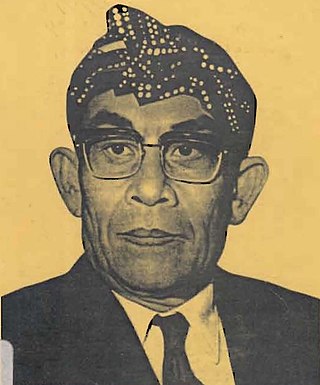
Anak Agung Pandji Tisna, also known as Anak Agung Nyoman Pandji Tisna, I Gusti Nyoman Pandji Tisna, or just Pandji Tisna, was the 11th descendant of the Pandji Sakti dynasty of Buleleng, Singaraja, which is in the northern part of Bali, Indonesia. He succeeded his father, Anak Agung Putu Djelantik, in 1944.

Dewa Made Beratha is the former governor of Bali. He is a member of the PDI-P, and allied to Megawati Sukarnoputri. On 2008 Balinese Governor Election, Beratha has been replacing by Made Mangku Pastika.
A Balinese name is part of a system of identification used by the Balinese people and in the western parts of the neighboring island of Lombok, Indonesia. A Balinese name will have three parts: a title, a birth order name and a personal name. Balinese people do not use a family name.

Danghyang Nirartha, also known as Pedanda Shakti Wawu Rauh, was a Shaivite religious figure in Bali and a Hindu traveler, during either the 15th or the 16th century. He was the founder of the Shaivite priesthood in Bali.
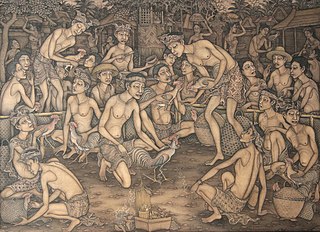
Balinese art is an art of Hindu-Javanese origin that grew from the work of artisans of the Majapahit Kingdom, with their expansion to Bali in the late 14th century. From the sixteenth until the twentieth centuries, the village of Kamasan, Klungkung, was the centre of classical Balinese art. During the first part of the twentieth century, new varieties of Balinese art developed. Since the late twentieth century, Ubud and its neighboring villages established a reputation as the center of Balinese art.
I Wayan Suweca is a highly respected performer of Balinese gamelan. Since the 1970s, he has taught and performed extensively throughout Asia, Europe, and America. In the early 1980s, along with his students Michael Tenzer and Rachel Ann Cooper, he founded and led the famous Sekar Jaya gamelan ensemble in Berkeley, California. In 1993, he cofounded the ensemble Giri Kedaton in Montreal. From 1982 to 2004, he was professor at the National Arts Academy of Indonesia (STSI) in Bali. From 1987 to 1993, he was a guest teacher at Université de Montréal in Canada and in Rochester, USA. For other students, See: List of music students by teacher: R to S#I Wayan Suweca.
I Nyoman Renbang (1937–2001) was an Indonesian musician, composer, teacher and instrument maker. He is considered by many ethnomusicologists as one of the most influential Balinese musicians and composers of the twentieth century.

The Neka Art Museum is a museum located in Ubud on Bali, Indonesia, It was established in 1982 by Pande Wayan Suteja Neka, better known as JMK Suteja Neka, a Balinese art dealer who had begun collecting Balinese art with the advice and help of painters Rudolf Bonnet and Arie Smit among others.
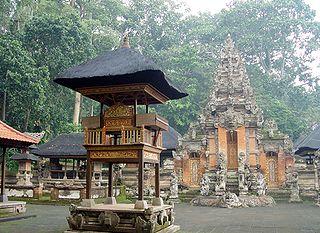
A Pura is a Balinese Hindu temple and the place of worship for adherents of Balinese Hinduism in Indonesia. Puras are built following rules, style, guidance, and rituals found in Balinese architecture. Most puras are found on the island of Bali, where Hinduism is the predominant religion; however many puras exist in other parts of Indonesia where significant numbers of Balinese people reside. Mother Temple of Besakih is the most important, largest, and holiest temple in Bali. Many Puras have been built in Bali, leading it to be titled "the Island of a Thousand Puras".
Balinese literature refers to the oral and written Balinese language literature of the people of Bali, an island in Indonesia. It is generally divided into two periods: purwa, or traditional; and anyar, or modern.
I Wayan Gobiah was a Balinese teacher and writer. He is best known for Nemoe Karma, a 1931 novel which is considered the first Balinese-language novel.
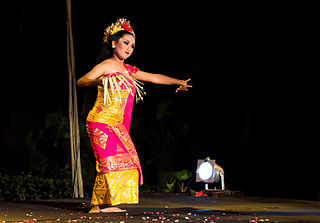
Panyembrama is a secular Balinese dance form designed by I Wayan Berata and first performed in 1971. It includes movements from several sacral Balinese dances. The dance was intended to replace for performances in front of tourists.
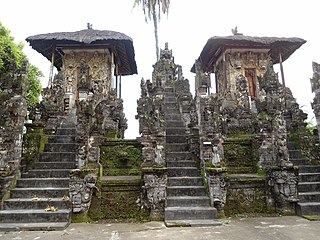
Pura Dalem Segara Madhu also known as Pura Dalem Jagaraga is a northern Balinese Hindu temple or pura located in the village of Jagaraga, Buleleng in northern Bali. It is about 11 km east of Singaraja. The village of Jagaraga is known historically as the place where the Dutch colonial government witnesses puputan or Balinese mass-suicide following their military attack on the kingdom of Bali in 1849. Pura Dalem Segara Madhu is known for its intensive wall decoration typical of northern Balinese architecture and for its unique western-influenced reliefs featuring early 20th-century airplanes and automobiles.

The 2018 Bali gubernatorial election took place on 27 June 2018 as part of the simultaneous local elections. It was held to elect the governor of Bali along with their deputy, whilst members of the provincial council will be re-elected in 2019.
Loloan Malays or Balinese Malays are a sub-ethnic group of the Malay who have lived in East Loloan and West Loloan villages, Jembrana, Bali, Indonesia, since the 17th century. There are approximately 28,000 Loloan Malays living in Bali.
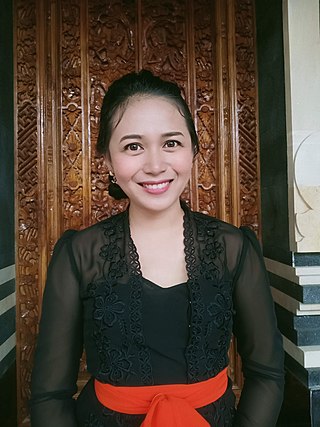
Dewa Ayu Carma Citrawati is an Indonesian writer, Balinese literature activist, and Wikimedian. She is well known for pioneering tasks to digitize and translate ancient Balinese palm-leaf manuscripts. On 15 August 2021, she was conferred with the award Wikimedian Newcomer of the Year during the 2021 virtual Wikimania conference.
Nyoman Tusthi Eddy was a Balinese writer who made significant contributions to the literary field in Amlapura. He was particularly known for his dedication to Balinese culture and literature in the eastern region of Karangasem. He wrote poems and articles that were published in newspapers such as Bali Post, Basis, Horison, Kompas, Sarad, Suara Karya, and Warta Hindu Darma. His works also appeared in cultural journals published in Malaysia and Brunei. In 1997, he published a study of the development of Balinese-language poetry during the previous three decades and praised the Bali Post for sponsoring much of this growth.













